Hey! Welcome to our Optavia sushi guide!
I’ve been trying out a lot of different sushi recipes like California rolls, Spicy tuna rolls, Tempuras, Sashimis, and others.
But, most of them had too many carbs and not enough proteins to fit into the Optavia diet plan.
However, my wife and I went on a mission to find other sushi recipes that are Optavia-approved and perfect for the 5 and 1 lean and green meal plan.
It was quite an adventure, let me tell you. We tried, tested, and even had a few close calls with some Wasabi and soy sauce, but we did it!
And now, I’m excited to share with you the list we came up with that perfectly fits the lean and green guidance. So, you can enjoy these sushi recipes without any worries or boundaries.
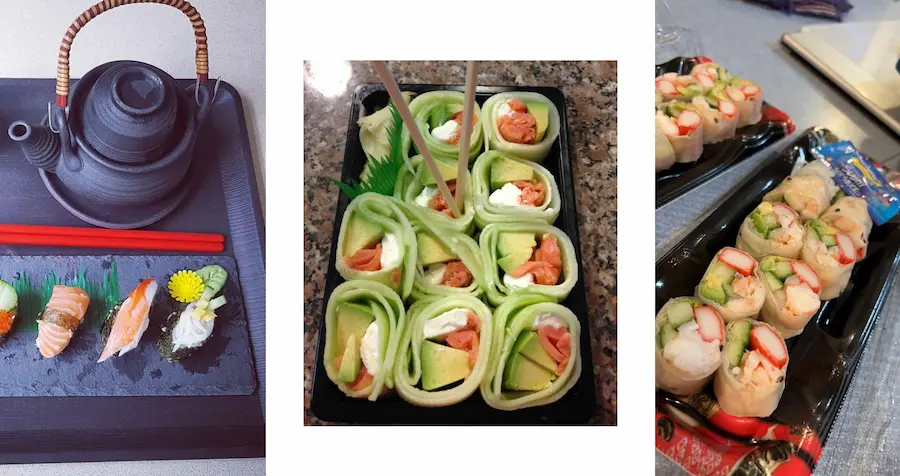
Can I have sushi on Optavia?
Yes, you can enjoy sushi on Optavia, but with certain restrictions. Sashimi-style sushi, such as salmon, tuna, shrimp, or crab, is allowed. However, sushi with rice, such as Maki sushi, Nigiri sushi, or California rolls, is not permitted on the Optavia program.
While it’s okay to indulge in a cheat meal once in a while, it’s important to stick to the Optimal Weight 5 and 1 plan to achieve the best possible results for your health and weight loss goals.
If you want to make DIY sushi at home, unfortunately, there is only one approved Optavia sushi recipe called “Korean Tuna Kimbap”. But the good news is that it’s a tasty and healthy option.
The Korean Tuna Kimbap recipe counts as 1 Leanest, 3 Greens, 2 Healthy Fats, 3 Condiments, and 1 Optional Snack. It’s a great option for those who love sushi but can’t have traditional sushi rice on the Optavia diet.
This recipe serves four people and each serving is two rolls. So, you can make it for a small group or meal prep for yourself for the week.
How to enjoy sushi on Optavia
Heading out for sushi tonight? Use this handy checklist to make sure you stay on track with your diet.
- Whenever I plan to dine out and have sushi, I always make sure to check the restaurant’s menu online beforehand or call them to see if they have a healthier alternative to traditional sushi rice, like cauliflower rice.
- Ask about the nutrition facts to ensure it matches my Optavia plan. I sometimes even ask the waiter to remove (or add) certain items like red ginger or wasabi to my order to make it more suitable for my plan, or even order an extra dish.
- I try to avoid sushi rolls that contain mayonnaise-based sauces such as spicy mayo or creamy sauces, as they can be high in calories and fat. But if they’re irresistible, I ask the waiter to serve them with a side or reduce the sauce.
- Soy sauce can also be high in sodium, so I use it sparingly. Sometimes, I ask for a low-sodium soy sauce or a soy sauce alternative like tamari.
- I prefer sushi or sashimi such as tuna, salmon, shrimp, or whitefish. They’re packed with lean protein sources. I recommend avoiding sushi or sashimi made with fried or breaded seafood.
What’s more, sushi rolls can vary in size, so I’m mindful of how much I’m eating.
If I’m looking for a lighter meal, I consider ordering sashimi or a smaller sushi roll. Before ordering, I also ask about its size and nutrition facts.
Optavia sushi options
If you’re a fan of sushi and following the Optavia program, below are options available when dining out at a restaurant.
We have compiled a list of several Optavia-friendly sushi choices to help you enjoy your night out without breaking your plan. Plus, be sure to take a look at our Optavia dining out guide for some additional tips to keep you on track.
Sashimi
To follow the Optavia plan, I immediately discovered sushimi, as they are usually served without rice feeding, which is very important for diet.
Sashimi is a dish made of thinly sliced raw meat, usually different types of fish, accompanied by soy sauce, wasabi, and pickled ginger.
Difference between sashimi and sushi:
- As we said sashimi is thinly sliced raw fish, served without rice, while sushi is a dish made of bite-sized pieces of raw fish served on top of rice
- Sashimi has the natural flavor and texture of the fish, while sushi has an extra flavor from the seasoned rice
- Sashimi is often served as a standalone dish or as part of a larger meal, while sushi is usually done as a complete meal in itself
You can order a fresh vegetable salad, grilled or steamed vegetables, as your green to make the most supplemented Lean and Green dish.
Also, it can be seaweed salad, which is a low-calorie food that is high in iodine, vitamins, and minerals, and it also contains some carbohydrates.
Let’s look out which sushimi is best suited for the Optavia plan and what are my favorites.
Salmon Sashimi (Sake)
Okay, here is the first sashimi with salmon, and I think it is no surprise because a lot of people like it too.
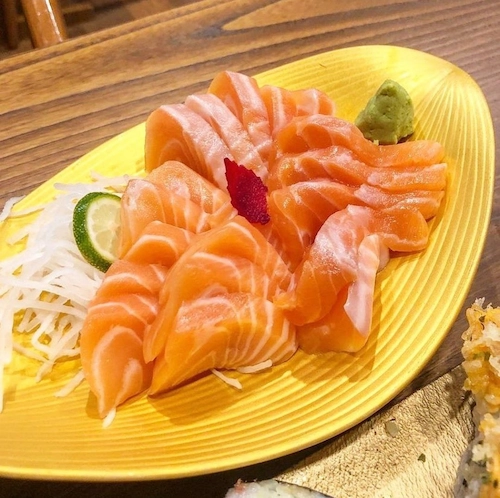
In addition to the fact that salmon has a tender, buttery texture that melts in your mouth, it also has such useful properties:
- Salmon is a good source of protein, and when consumed as sashimi, it is an excellent way to get a high-quality protein that is low in fat and calories
- Also, it is rich in omega-3 fatty acids, which are essential for maintaining healthy brain function
- Usually, it is made from raw salmon, which is typically very fresh. This freshness is reflected in the delicate, clean taste of the salmon
- And salmon sashimi has a distinct, slightly sweet flavor that is unique to this type of fish. This flavor is enhanced by the addition of soy sauce and wasabi, which help to bring out the natural sweetness of the salmon
As you can see from the nutrition facts, you can eat around 5 ounces of salmon on the Optavia plan.
Plus some vegetables as your green and a small portion of soy sauce (I try to use really a little bit to avoid calories and sodium content).
Nutrition facts
- Portion: 1 oz
- Calories: 52
- Carbs: 0 grams
- Fats: 3.1 grams
- Proteins: 5.6 grams
Sweet Shrimp Sashimi (Amaebi)
The most popular types of raw shrimp that can be used for sushimi are Ama Ebi (Sweet Shrimp) and Kuruma Ebi (Japanese Tiger Prawn).
I prefer sweet shrimp like in the photo below, but I still recommend trying both.
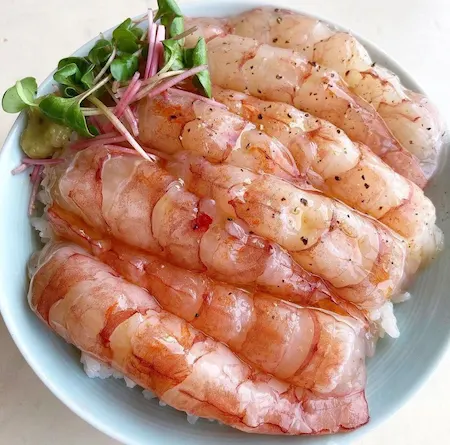
The unique sweetness and mild taste of these coldwater shrimp make them highly sought-after in Japan, although they can be cooked if desired.
However, make sure to ask to do this for a short period of time, cooking will typically remove the delicate sweet flavor that gives them their appeal.
For sweet shrimp sashimi, you can have a serving portion of around 6 oz. But complement your dish as much as possible and stay on track with Optavia, you need to add 3 portions of greens to your taste and you’re done.
Nutrition facts
- Portion: 1 oz
- Calories: 30
- Carbs: 0.2 grams
- Fats: 0.5 grams
- Proteins: 5.8 grams
Other Sashimi you can enjoy on Optavia
I wrote my favorite type of sashimi, but Japanese contains a lot of other fish like tuna, red snapper, or yellowtail, which taste even better for someone.
If you have tried the classic types of sashimi such as tuna and salmon and want to try something new, this table would be a good choice sashimi for your next adventure.
In many places, you can order a plate of mixed sashimi, which is perfect for sharing with friends.
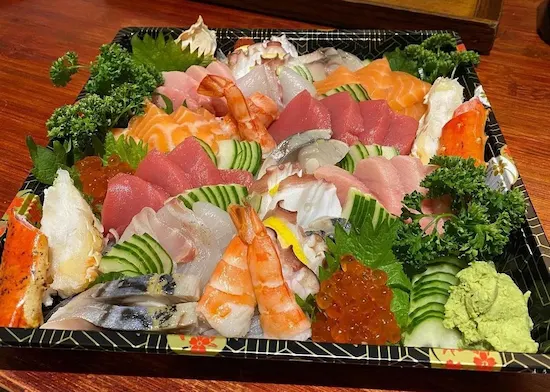
This table contains information about calories, carbs, and proteins, which helps you understand the portion size for your meal on Optavia.
Usually, I count sashimi as my lean and just add extra green. If fish don’t contain healthy fat, I add a salad with some oil or seeds.
Table of different types of Sashimi:
| Name | Size | Kcal | Carbs | Fat | Protein |
|---|---|---|---|---|---|
| Abalone | 1 oz | 30 | 1.7 | 0.2 | 4.8 |
| Tuna Sashimi | 1 oz | 40 | 0 | 1.4 | 6.6 |
| Albacore | 1 oz | 49 | 0 | 2.1 | 7.2 |
| Conger Eel | 1 oz | 40 | 1.4 | 0 | 6.6 |
| Founder Sashimi | 1 oz | 26 | 0 | 0.3 | 5.3 |
| Giant Scallop | 1 oz | 26 | 0.7 | 0.2 | 5 |
| King Crab Leg | 1 oz | 27 | 0 | 0.4 | 5.5 |
| Octopus Sashimi | 1 oz | 46 | 1.3 | 0.6 | 8.5 |
| Red Snapper | 1 oz | 22 | 0 | 0.4 | 5.8 |
| Salmon Roe | 1 oz | 19 | 0.2 | 0.9 | 3.1 |
| Sardine | 1 oz | 59 | 0 | 3.3 | 7 |
| Whitefish | 1 oz | 21 | 0 | 1.7 | 5.4 |
| Yellowtail | 1 oz | 41 | 0 | 1.5 | 6.6 |
Sashimi Rolls
Another great idea for those who still like a roll and not just fish separately. You can try the sashimi, which transforms it into a roll.
My favorite place is Wegmans, where they have this type of sashimi roll with rice paper, crab and shrimp, and cucumber but without rice. In the photo below, I am having lunch with my wife.
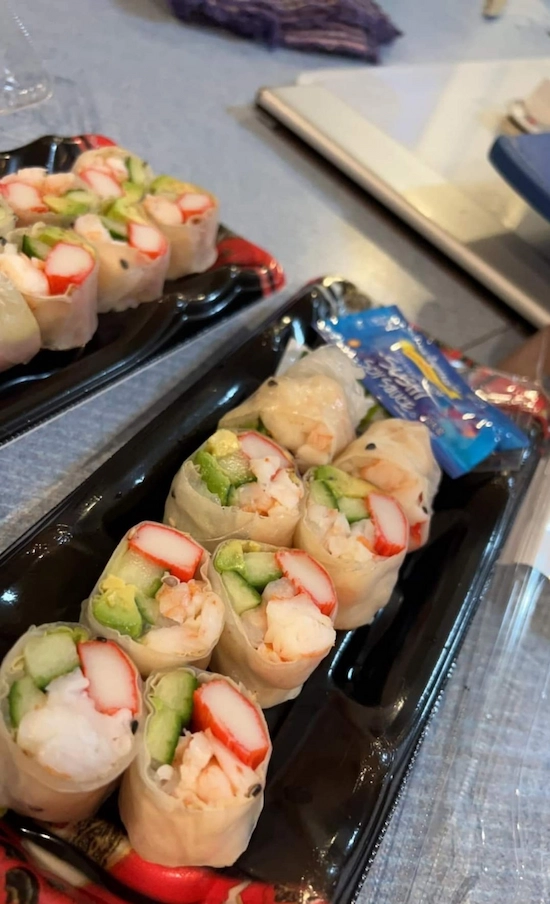
Usually, sashimi rolls can contain these types of ingredients:
- Tuna, salmon, yellowfish, crab, crab sticks, and other types of fish
- Veggies can be avocado, lettuce, red cabbage, microgreen, cucumber, and other
- Wrap into nori or rice paper
- Served with wasabi, soy sauce, and pickled ginger
Since these rolls contain different types of fish and vegetables, they can be a complete lean and green meal at Optavia.
If you are going to order, ask first about the nutrition facts to understand whether everything is suitable for you.
If not, you can always order additional fish or salad to complement your Lean and Green, or if your meal has too many calories, carbs, or fats, you can ask to remove some ingredients.
Also, these rolls are quite easy to prepare at home and have a lot of recipes you can find very quickly on the internet, and the most important thing is that you can simply calculate all the ingredients that you add.
Making your own sushi is easy once you have the right tools at hand. You’ll need a sushi bamboo mat.
Besides this, you’ll need a sharp knife as well as a food processor – they’re both necessary to get the texture of the sushi right.
Finally, don’t forget to get an airtight container if you plan on storing any of your leftovers.
Naruto Roll with Cucumber
Naruto sushi, also known as narutomaki sushi or naruto roll, is a type of sushi roll that originated in Japan. The role is named after narutomaki, which is a type of fish cake that is often used as a filling in the roll.
While sushi typically comes with nori and rice, naruto rolls are a delicious substitute if you wish to enjoy your favorite sushi flavors and stay with the Optavia plan.
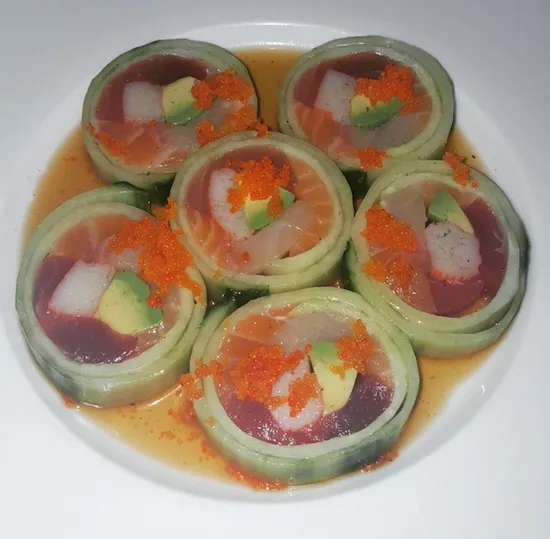
Naruto rolls often consist of all the typical sushi ingredients—such as fish, vegetables, and avocado—but are wrapped in cucumber strips or slices instead of nori.
Another notable distinction between sushi and sashimi is the presence of raw meat in sashimi, as we already wrote.
If you don’t want raw meat with your meal but still would like to savor some of its other non-raw components, then the naruto roll is another option that may be an ideal one for you.
Sushi with Cauliflower
Sushi with cauliflower is a great option for those looking for a nutritious and delicious meal option, especially if you’re following an Optavia plan.
To order, simply ask your server or sushi chef – many restaurants are now offering this unique variation on traditional sushi.
Some sushi restaurants may have it listed as “cauliflower rice sushi”, “veggie sushi” or “Keto sushi” on their menu.
Here is my order of cauliflower sushi with salmon, crab, and tuna for me and my wife.
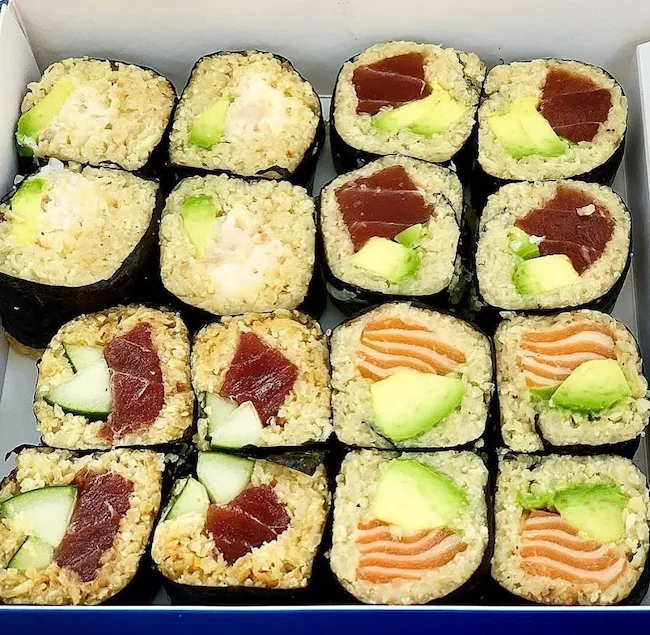
The components of sushi with cauliflower are similar to those of a regular sushi roll:
- Nori (dried seaweed)
- Different types of fish or seafood
- Fresh vegetables such as avocado, cucumber, or even fried eggs
- Sauces or cream cheese
Common fish options include salmon, tuna, shrimp, and crab.
All of these carefully-selected ingredients come together to make sushi with cauliflower a meal that doesn’t skimp on flavor or nutrition while still being tasty and enjoyable on the Optavia diet.
And here you can see my homemade cauliflower sushi with salmon, canned tuna, ground crab, and light cream cheese. It’s not as nice as I would have liked, but it was still tasty.
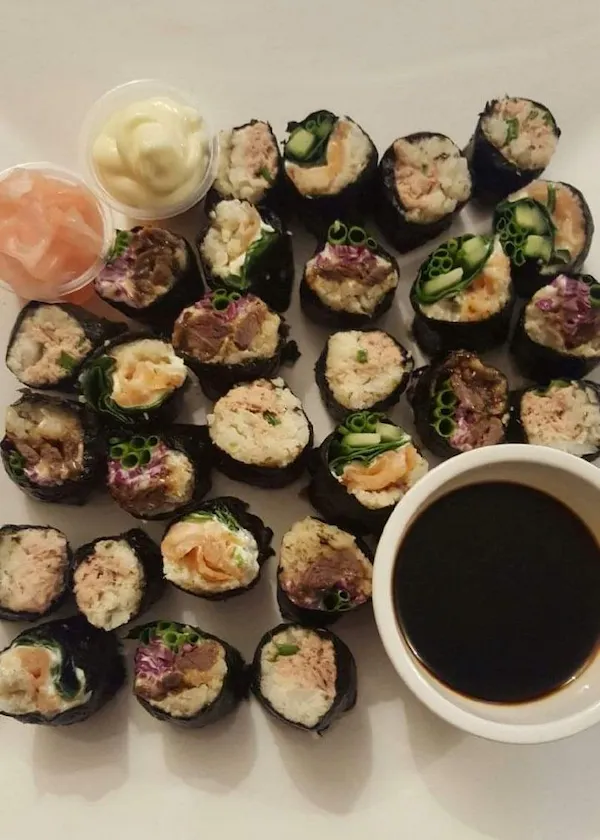
Poke Sushi Bowl
The sushi bowl is a traditional Japanese dish that offers all the delicious flavors of sushi but in a much simpler way.
It typically includes a bed of rice or cauliflower rice on the bottom with sliced raw fish or cooked seafood, vegetables, and other toppings such as avocado, cucumber, pickled ginger, seaweed salad, and wasabi.
Tip to order poke bowl on Optavia:
- Choose for base cauliflower rice, noodles like zucchini squash, yellow squash, and butternut squash
- When choosing a sauce for your poke bowl, aim for one that is lower in calories and sodium
- To ensure you get enough protein, carbs, and healthy fats in your poke bowl, check the nutrition facts and add extra ingredients if needed. I usually ask about the portion of fish to be sure that it is around 5 – 6 ounces to keep the level of protein from Lean and Green meals, as in restaurants it is usual to add more veggies than protein
- Toppings like fried onions, crispy wontons, or spicy mayo can add a lot of calories and unhealthy fats to your poke bowl. Instead, choose toppings like seaweed salad, pickled ginger, or fresh herbs
- Most poke restaurants allow you to customize your bowl, so take advantage of this and tailor your bowl to your specific dietary needs and preferences and avoid processed food at the same time
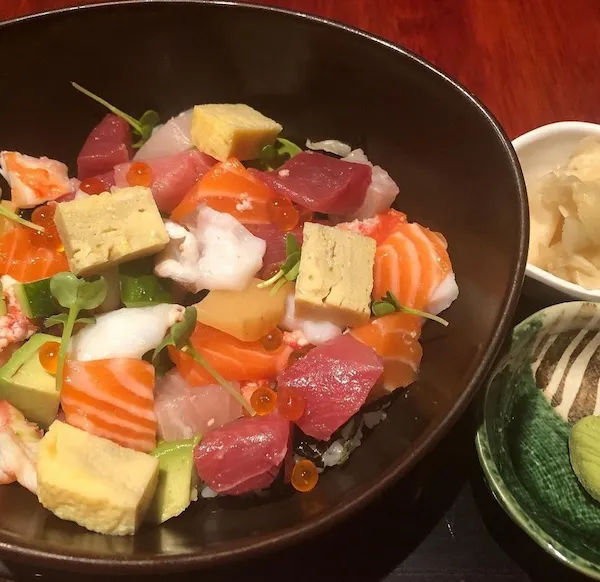
Using these tips, you can always find a way to stay with the Optavia plan and still enjoy the sushi bowl like in the photo.
